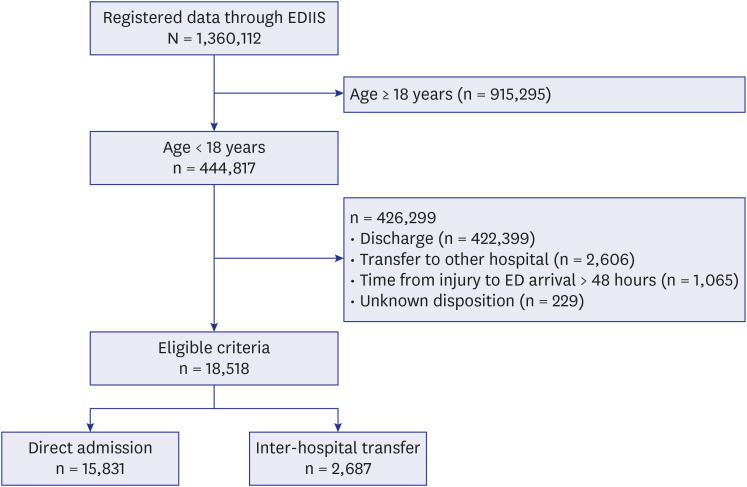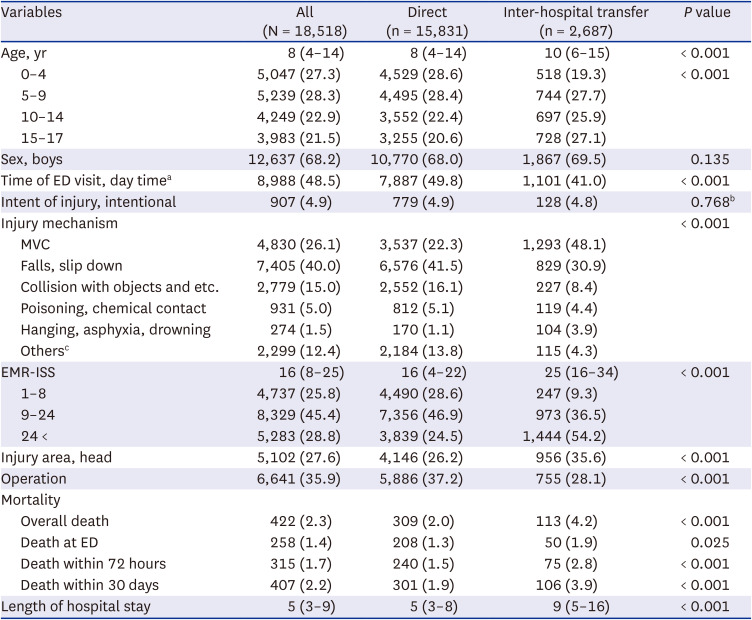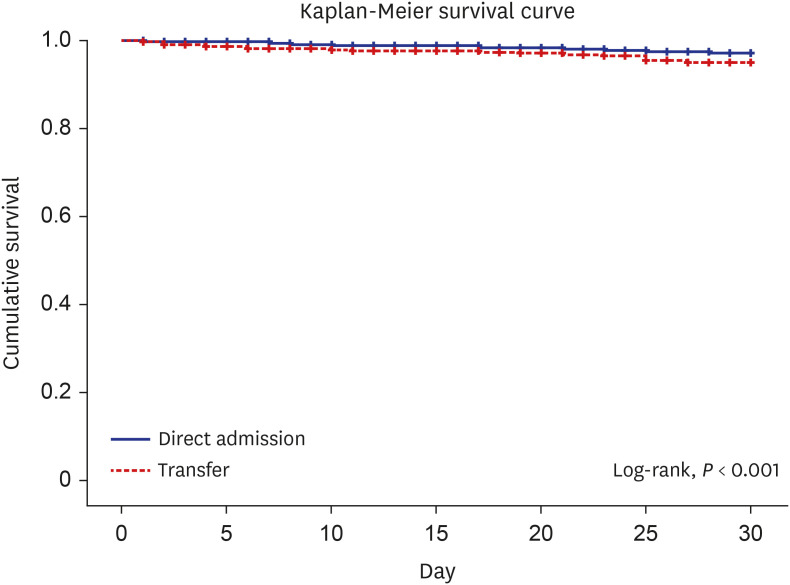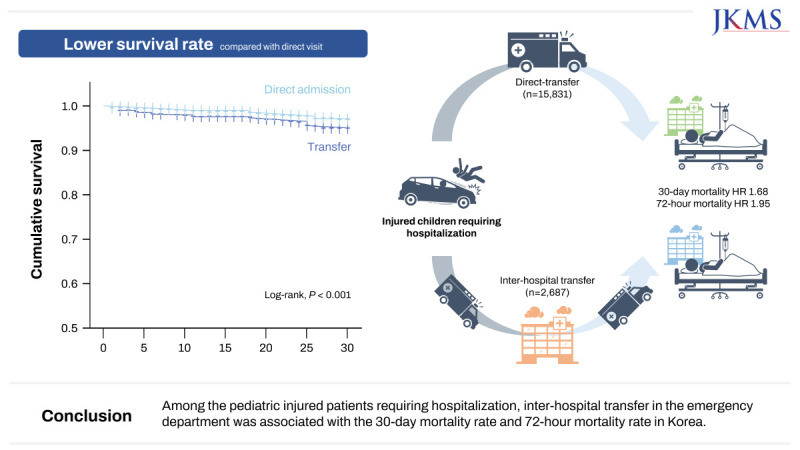1. Yeon GM, Hong YR, Kong SG. Nonfatal injuries in Korean children and adolescents, 2007-2018. Clin Exp Pediatr. 2022; 65(4):194–200. PMID:
34530522.
4. Kim H, Jung KY, Kim SP, Kim SH, Noh H, Jang HY, et al. Changes in preventable death rates and traumatic care systems in Korea. J Korean Soc Emerg Med. 2012; 23(2):189–197.
5. Kwon J, Lee M, Moon J, Huh Y, Song S, Kim S, et al. National follow-up survey of preventable trauma death rate in Korea. J Korean Med Sci. 2022; 37(50):e349. PMID:
36573386.
6. Jung K, Matsumoto S, Smith A, Hwang K, Lee JC, Coimbra R. Comparison of outcomes in severely injured patients between a South Korean trauma center and matched patients treated in the United States. Surgery. 2018; 164(3):482–488. PMID:
29884477.
7. Kim YJ, Hong JS, Hong SI, Kim JS, Seo DW, Ahn R, et al. The prevalence and emergency department utilization of patients who underwent single and double inter-hospital transfers in the emergency department: a nationwide population-based study in Korea, 2016-2018. J Korean Med Sci. 2021; 36(25):e172. PMID:
34184436.
8. Lee DJ, Ko SH, Kang J, Kim MC, Choi HZ. Survival benefit of direct transport to trauma centers among patients with unintentional injuries in Korea: a propensity score-matched analysis. Clin Exp Emerg Med. 2023; 10(1):37–43. PMID:
36174974.
9. Locke T, Rekman J, Brennan M, Nasr A. The impact of transfer on pediatric trauma outcomes. J Pediatr Surg. 2016; 51(5):843–847. PMID:
26932250.
10. Odetola FO, Mann NC, Hansen KW, Patrick S, Bratton SL. Source of admission and outcomes for critically injured children in the mountain states. Arch Pediatr Adolesc Med. 2010; 164(3):277–282. PMID:
20194263.
11. Kim J, Shin SD, Im TH, Ko SB, Park JO, Ahn KO, et al. Kug Jong Lee. Development and validation of the excess mortality ratio-adjusted injury severity score using the International Classification of Diseases 10th Edition. Acad Emerg Med. 2009; 16(5):454–464. PMID:
19388920.
12. Yohann A, Kratzke I, Williams B, Charles A. The effect of transfer status on trauma outcomes in low- and middle-income countries: a systematic review and meta-analysis. Injury. 2022; 53(3):885–894. PMID:
34689985.
13. Hill AD, Fowler RA, Nathens AB. Impact of interhospital transfer on outcomes for trauma patients: a systematic review. J Trauma. 2011; 71(6):1885–1900. PMID:
22182900.
14. Johnson DL, Krishnamurthy S. Send severely head-injured children to a pediatric trauma center. Pediatr Neurosurg. 1996; 25(6):309–314. PMID:
9348151.
15. Larson JT, Dietrich AM, Abdessalam SF, Werman HA. Effective use of the air ambulance for pediatric trauma. J Trauma. 2004; 56(1):89–93. PMID:
14749572.
16. Gunst M, Ghaemmaghami V, Gruszecki A, Urban J, Frankel H, Shafi S. Changing epidemiology of trauma deaths leads to a bimodal distribution. Proc Bayl Univ Med Cent. 2010; 23(4):349–354. PMID:
20944754.
17. Nirula R, Maier R, Moore E, Sperry J, Gentilello L. Scoop and run to the trauma center or stay and play at the local hospital: hospital transfer’s effect on mortality. J Trauma. 2010; 69(3):595–599. PMID:
20838131.
18. Sampalis JS, Denis R, Fréchette P, Brown R, Fleiszer D, Mulder D. Direct transport to tertiary trauma centers versus transfer from lower level facilities: impact on mortality and morbidity among patients with major trauma. J Trauma. 1997; 43(2):288–295. PMID:
9291375.
19. American College of Surgeons. Resources for the Optimal Care of the Injured Patient. Chicago, IL, USA: American College of Surgeons;2006.
20. Bos N, Hendriks M, Booys M, Wets M. Spoed Moet Goed: Indicatoren en Normen voor zes Spoedzorgindicaties. Diemen, Netherlands: Zorginstituut Nederland;2015.
21. Chaichotjinda K, Chantra M, Pandee U. Assessment of interhospital transport care for pediatric patients. Clin Exp Pediatr. 2020; 63(5):184–188. PMID:
31477679.
22. Knight PH, Maheshwari N, Hussain J, Scholl M, Hughes M, Papadimos TJ, et al. Complications during intrahospital transport of critically ill patients: Focus on risk identification and prevention. Int J Crit Illn Inj Sci. 2015; 5(4):256–264. PMID:
26807395.
23. Jouvet P, Lacroix J. Improving interhospital paediatric transport. Lancet. 2010; 376(9742):660–661. PMID:
20708257.
24. Calhoun A, Keller M, Shi J, Brancato C, Donovan K, Kraus D, et al. Do pediatric teams affect outcomes of injured children requiring inter-hospital transport? Prehosp Emerg Care. 2017; 21(2):192–200. PMID:
27636186.
25. Statistics Korea. Causes of death statistics in 2021. Updated 2022. Accessed January 7, 2023.
http://www.kostat.go.kr
.








 PDF
PDF Citation
Citation Print
Print




 XML Download
XML Download